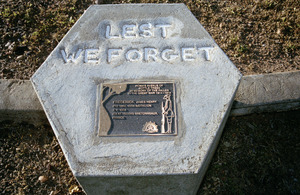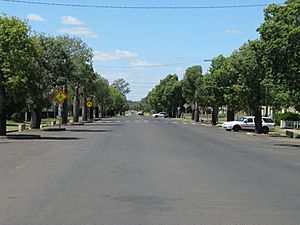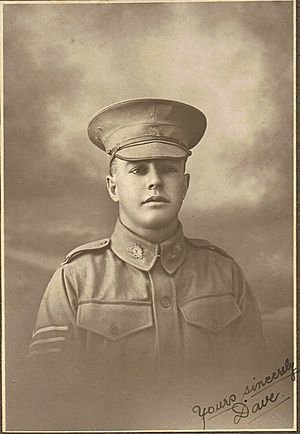Roma War Memorial and Heroes Avenue facts for kids
Quick facts for kids War Memorial and Heroes Avenue |
|
|---|---|

Roma War Memorial, 2010
|
|
| Location | Bungil Street, Roma, Maranoa Region, Queensland, Australia |
| Design period | 1919 - 1930s (interwar period) |
| Built | 1920 |
| Official name: War Memorial and Heroes Avenue | |
| Type | state heritage (built, landscape) |
| Designated | 21 October 1992 |
| Reference no. | 600824 |
| Significant period | 1920- (social) 1920,1938, 1983 (historical) 1920s-1930s (fabric) |
| Significant components | tree groups - avenue of, memorial - plaque, park / green space, memorial - cenotaph, memorial - cairn, trees of social, historic or special significance, pathway/walkway, memorial - tree/avenue of trees |
| Lua error in Module:Location_map at line 420: attempt to index field 'wikibase' (a nil value). | |
The War Memorial and Heroes Avenue is a special place in Roma, Australia. It remembers brave soldiers. This heritage-listed memorial is on Bungil Street. It was built in 1920 and is a very important part of Queensland's history. It was added to the Queensland Heritage Register on 21 October 1992.
Contents
Remembering Our Heroes: A Look at Roma's War Memorial
The Roma War Memorial was built in two main parts. First, the rows of trees were planted. Then, the main stone monument, called a cenotaph, was added.
The Heroes Avenue: Trees of Remembrance
By 1920, 93 bottle trees (Brachychiton rupestris) were planted. These trees formed the Heroes Avenue. They were the first way to remember local men who died in World War I. The first 27 trees were planted on 20 September 1918.
Each tree originally had a brass plaque. This plaque showed the name of one of the 93 local men who died. Today, only one of these original plaques remains. It is now on a stone pillar, called a cairn. This cairn was dedicated on Remembrance Day in 1983. You can find it near the Post Office. The cairn also lists all 93 names. Some of the original trees have been replaced over time. Others were removed to make way for roads.
How the Heroes Avenue Began
The idea for the Heroes Avenue came from Roma's Mayor, Alderman Miscamble. He had seen similar memorial tree avenues in other parts of Australia. Bottle trees were chosen because they are common in Roma. The first tree was likely planted in 1918. It honored Lt Cpl Norman Saunders, a local soldier. He died in France in 1916. This tree is outside the Post Office and is known as the Tree of Knowledge. More trees were planted to remember other soldiers. Even though most plaques are gone, each tree still honors a specific soldier.
The Cenotaph: A Stone of Honor
The main monument, the Cenotaph, is in Queen's Park. It was built by the Local Repatriation Committee. It was officially revealed on Anzac Day, 25 April 1938. This monument honors the 93 men from World War I. It also remembers 39 men who died in World War II. Building the cenotaph took time. The committee first focused on helping soldiers who returned from war. They had already put up a memorial board in the Town Hall.
Behind the Cenotaph are nine pine trees. People say these trees grew from seeds. These seeds were supposedly collected from the famous Lone Pine at Gallipoli. Every year, the traditional ANZAC Day march starts at the Roma railway station. It ends at the cenotaph in Queen's Park.
Why War Memorials Are Important
Before World War I, Australia had few public monuments. The memorials built after the war were our first national monuments. They showed how much the war affected the young country. Australia lost 60,000 people from a population of about 4 million. This was one out of every five who served. No other war has had such a big impact.
Even before the war ended, memorials became a way to show national sadness. For those who built them, they were like sacred graves. They were substitute graves for Australians buried overseas. The word "cenotaph" means "empty tomb." Australian war memorials are special. They remember not only those who died. They also honor all who served from a local area. This shows how much communities were involved in the war.
What the Memorial Looks Like
The First World War Memorial covers a large area. It includes the rows of trees, the stone cairn, and the main cenotaph.
The Avenue of Bottle Trees
The avenue of trees starts at the Roma railway station. It turns right into Wyndham Street. Then it turns left into Bungil Street. It ends just after Hawthorne Street. There are more than 90 trees. All of them are bottle trees (Brachychiton rupestris).
The Cairn at the Post Office
The cairn is outside the Post Office. It is a white concrete pillar. It has a large sloped top corner. On this sloped part, there is a bronze plaque. It lists the names of the 93 local men who died in World War I. These names were originally on plaques on each tree.
The Cenotaph in Queen's Park
The main memorial is in Queen's Park. It is a cenotaph sitting on a slightly larger base. Both are made of light grey granite. The cenotaph has three marble plaques. These plaques are set into the granite. The front plaque faces Bungil Street. It has Laurence Binyon's poem "For the Fallen". Above it is a bronze AIF badge. The back plaque lists the 93 names of the fallen. Above it is a bronze laurel wreath. A newer plaque was added to the eastern side. It remembers the 39 local men who died in the Second World War.
The cenotaph is in the middle of a paved area. It faces the end of the bottle tree avenue. It is surrounded by paths and grassy areas. Nine pine trees form a semi-circle around it. These trees are said to have grown from seeds from the Lone Pine at Gallipoli.
Soldiers Remembered at the Memorial
Here are some of the soldiers remembered by the War Memorial and the bottle tree avenue:
- Neil McMaster Crawford, Private 31st Battalion. He died on 26 September 1917 at the Battle of Menin Road.
- James Henry Frederick, Private 25th Battalion. He died on 4 July 1918. His memorial is at Crucifix Corner Cemetery Villers-Bretonneux, The Somme, France.
- David Alexander Murphy, Lance Corporal 15th Battalion. He was a cabinet maker and a friend of Neil Crawford. He died at Polygon Wood on 26 September 1917. His memorial is on Menin Gate, Ypres.
Why This Place is Special
The War Memorial and Heroes Avenue is listed on the Queensland Heritage Register. It was added on 21 October 1992. It meets several important standards.
Showing Queensland's History
War memorials help us understand Queensland's history. They show how communities across the state honored soldiers. They also show a time of strong national pride, especially after World War I. The Roma avenue of trees was planted by 1920. The cenotaph was built in 1938.
A Rare and Special Memorial
Avenues of trees used as memorials are not common in Queensland. Especially rare are those where each tree honors a specific fallen soldier. Most memorials built after World War I were large stone monuments.
A Great Example of a Memorial
This memorial shows what a good commemorative structure looks like. It uses suitable materials and design. It is a lasting record of a major historical event.
Beautiful and Important to See
The war memorial trees are one of the most impressive in Queensland. They are beautiful and stand out in the town. This makes them very important to the area.
Strong Community Connection
This memorial has a strong and ongoing connection with the community. It shows the impact of a major historical event. It is a central place for people to remember that event.




